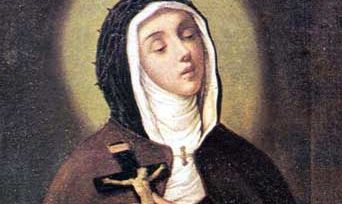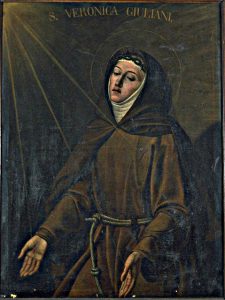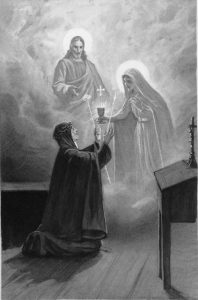
St. Veronica Giuliani was a Capuchin abbess, and a recipient of extraordinary mystical spiritual gifts. In 1660 Ursula Giuliani was born to her parents Francesco and Benedetta at Mercatello, located in the Duchy of Urbino in north central Italy. Ursula was one of five girls. Benedetta was a very devout woman, who read the stories of the saints to her children, but who died when Ursula was just seven. Even from early childhood, Ursula showed unusual signs of devotion, and had her first vision and locution of Christ at age four. She would take from her own clothing and food to give to the poor when she encountered them. From an early age, she had a great devotion to venerating the five wounds of Christ’s Passion. When she received her First Holy Communion at age ten, she knew she had a vocation to consecrated religious life. Francesco wished for Ursula to be married and arranged for several suitors to court her, but she refused. At last, he gave his consent for her to begin a religious life, and she joined the Capuchin Poor Clares at age seventeen. The bishop who performed the rite of her entrance predicted to the nuns that she would become a great saint, and he chose for her the religious name Veronica, in honor of the woman who is known traditionally to have comforted Christ during His walk to Calvary.
MYSTICAL EXPERIENCES CONTINUE INTO RELIGIOUS LIFE
During her novitiate, the visions of Veronica’s childhood continued, and she continued to be drawn toward meditation on Christ’s suffering and on doing numerous penances for the intention of converting sinners. The Lord would occasionally allow her to have visions of souls in great danger and of their conversion back to God. She endured a period of spiritual aridity, a longing to give herself to God and feeling that He rejected her love. On Good Friday of 1681, the Lord placed a crown of thorns on her head in a vision, and the markings of the wounds appeared on her head thereafter accompanied by much pain. She was given medical treatment ordered by her bishop for the wounds and swelling, but she did not disclose the supernatural nature of the wounds, and the treatments were useless.

INVISIBLE SPIRITUAL REALITIES EXPERIENCED
In 1682, she was chosen to serve as novice-mistress, and she guided her young sisters with much care, shielding them from knowledge of her supernatural experiences and sufferings. She served in this capacity for thirty four years. In 1693, in obedience to her confessor, she began writing her diary. She wrote faithfully for the remainder of her life, compiling twenty two thousand pages of written text. Considering her other responsibilities, the writing of her diary often required her to write very late into the night. She would frequently experience demonic attacks while she wrote, but the Lord made it clear to her that He wanted her to write. The demonic attacks sometimes took the form of a vicious cat, and when she would do penances, she would hear terrible screams and animal sounds. During the course of these many years of mystical visions, Veronica had several visions of hell and of purgatory. Her visions of hell were horrendous, as she saw, smelled and heard during the experiences. It moved her very deeply to see souls so tormented and without hope. At one of these experiences, she offered herself as a doorway, standing in the breach of the gate of hell to try to turn souls away while they still had time to repent. The Virgin Mary told her that many people do not believe that hell exists, and this to their peril. In 1694, Veronica experienced a vision where Christ showed her [St.] Catherine of Siena, another extraordinary mystic, and gave her to Veronica as a guide and companion.
RECEPTION OF CHRIST’S WOUNDS
 In 1696, Veronica received the beginning of the stigmata wounds, a wound to the heart from her side, a phenomenon similarly experienced by [Sts.] Teresa of Avila and Philip Neri. She described the wound as feeling like a constantly burning flame. The following year, on Good Friday, she received the remaining stigmata wounds, those to her hands and feet. She wrote that they came to her as shining rays from the wounds of Christ crucified that she experienced in a vision, nearly identical to the experience of [Sts.] Francis of Assisi and Pio. The reception of the stigmata was a humiliating experience for her, as it was for the other saints who received it. Her bishop placed her under a series of difficult tests and treatments to find the cause of her wounds. He even removed her from the conventual community life and placed her in isolation for a time to be watched around the clock. When he was convinced that these wounds were of supernatural origin, she returned to her usual duties, and her wounds were declared to be authentic stigmata. The Virgin Mary was frequently present in the visions which were often interactive and visible to no one but Veronica. In her writings, Veronica emphasized the importance of consecration to Mary. Veronica’s guardian angel played a notable role in her daily life. Because the demonic attacks were so frequent and intense, the Virgin Mary sent another angel to help her. Once, when a great fire broke out due to a chapel candle and panic ensued, Veronica calmly approached the fire, made the sign of the cross, and the flames retreated, sparing the convent from destruction.
In 1696, Veronica received the beginning of the stigmata wounds, a wound to the heart from her side, a phenomenon similarly experienced by [Sts.] Teresa of Avila and Philip Neri. She described the wound as feeling like a constantly burning flame. The following year, on Good Friday, she received the remaining stigmata wounds, those to her hands and feet. She wrote that they came to her as shining rays from the wounds of Christ crucified that she experienced in a vision, nearly identical to the experience of [Sts.] Francis of Assisi and Pio. The reception of the stigmata was a humiliating experience for her, as it was for the other saints who received it. Her bishop placed her under a series of difficult tests and treatments to find the cause of her wounds. He even removed her from the conventual community life and placed her in isolation for a time to be watched around the clock. When he was convinced that these wounds were of supernatural origin, she returned to her usual duties, and her wounds were declared to be authentic stigmata. The Virgin Mary was frequently present in the visions which were often interactive and visible to no one but Veronica. In her writings, Veronica emphasized the importance of consecration to Mary. Veronica’s guardian angel played a notable role in her daily life. Because the demonic attacks were so frequent and intense, the Virgin Mary sent another angel to help her. Once, when a great fire broke out due to a chapel candle and panic ensued, Veronica calmly approached the fire, made the sign of the cross, and the flames retreated, sparing the convent from destruction.
COMMON SENSE ABBESS
In 1716, Veronica was elected abbess, and served in that role for the rest of her life. Despite her extraordinary spiritual life, she was a very competent leader for her sisters. She enlarged the convent, had running water installed, and guided her charges with good common sense. On June 6, 1727, at the moment she received Holy Communion, she suffered a massive stroke, and died July 9, uttering the last words, “Love has let Himself be found”. She was sixty six years old at the time of her death. An autopsy revealed that her heart bore the imprints of the cross and several of the instruments of Jesus’ passion.
WHY MYSTICS MATTER
The life of St. Veronica Giuliani was truly extraordinary. She was given the gift to see the invisible spiritual realities that are mercifully veiled from the rest of us. Like a number of more well-known mystics and stigmatics, she accepted the burdens and gifts with a willing and obedient spirit. She was tremendously devoted to the passion of Christ, and He chose her to participate in that passion in her own time for the salvation of souls in a very special way. It must be remembered that when St. Paul tells us, “Now I rejoice in my sufferings for your sake, and in my flesh I am filling up what is lacking in the afflictions of Christ on behalf of his body, which is the church…”, we learn that Christ allows each of us to participate in the salvation He made possible, and that our penances and abstinences, however small, really do help Him. Veronica’s amazing diary lay dormant for more than a century, until a series of five different men were able to scrutinize and publish the massive and complex work. Finally, the diary was published in ten volumes in 1927. A one volume abridged version was made available later. St. Veronica was beatified in 1804 and canonized in 1839. Her body remains incorrupt and is at her shrine at the Monastery of St. Veronica Giuliani, Città di Castello, Italy. Her feast day is July 9.
